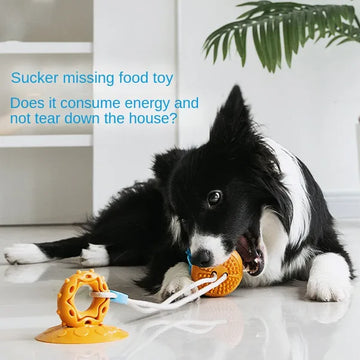When it comes to keeping our furry friends happy and entertained, dog toys are essential. However, one common question many pet owners have is, "How long do dog toys last?" While the lifespan of a dog toy varies significantly based on the type of toy, the materials used, and the play style of the dog, understanding these factors can help you make informed choices. In this article, we’ll explore the typical lifespan of various types of dog toys, factors that impact durability, and some helpful tips to extend the life of these beloved items.
What Factors Influence the Lifespan of Dog Toys?
Dog toys come in many materials, shapes, and sizes, which each factor into how long they last. Here are some main considerations that affect toy durability:
- Material: Toys made from rubber, nylon, or tough canvas tend to last longer than those made from softer fabrics or plastics. Stronger materials are better suited to dogs who enjoy chewing or tugging.
- Type of Toy: Different types of toys have different lifespans. For instance, plush toys may only last a few days with a heavy chewer, while durable rubber toys can last months or even years.
- Dog's Chewing Style: A dog who loves to chew and bite toys vigorously will wear them out faster than a gentle player. Knowing your dog’s play style can help you choose toys that will last longer.

- Quality of Construction: Toys from reputable brands that focus on durability often last longer because they are designed to withstand the wear and tear of active play. Strong stitching, for example, can make a significant difference in a toy’s longevity.
- Frequency of Play: Toys that are played with daily are likely to wear out faster than toys that are used occasionally. Regular play results in more wear and tear, so it’s good to rotate toys to ensure even use.
Typical Lifespan of Different Types of Dog Toys
Let’s take a closer look at how long various types of dog toys typically last, assuming they’re used by an average dog.
Rubber Chew Toys
Rubber toys, such as KONGs, are designed for durability and can last for months or even years, depending on the dog’s chewing habits. They’re usually tough enough to withstand rigorous chewing, which makes them ideal for heavy chewers. High-quality rubber toys often last significantly longer than other materials, especially when properly maintained.
Nylon Bones
Nylon bones are another durable option for heavy chewers. These bones are designed to be chewed over a long period, gradually wearing down without breaking apart. Depending on your dog’s chewing strength, a nylon bone may last anywhere from a few months to over a year.
Plush Toys
Plush toys, while adorable and soft, generally have the shortest lifespan, especially if your dog loves to rip toys apart. These toys can last a few days to a few weeks with moderate play, but they’re often not suitable for heavy chewers. For gentle dogs, plush toys may last longer, but it’s best to supervise play with these types of toys.
Rope Toys
Rope toys are generally used for tugging games rather than heavy chewing. They can last anywhere from a few weeks to a few months, depending on how vigorously they’re used. Regularly checking rope toys for fraying or unraveling is essential to prevent any choking hazards as they wear down.
Puzzle Toys
Puzzle toys are designed for mental stimulation rather than physical chewing, so they can last a long time if handled with care. With occasional use and proper supervision, puzzle toys can last for months or even years. They’re a great option for dogs who enjoy interactive play.
Dog Toys for Small Dogs: Choosing Durable and Safe Options
Smaller breeds have specific needs when it comes to choosing toys. Dog toys for small dogs should be appropriately sized to avoid any choking hazards while still being durable enough to withstand play. For small breeds that are gentle chewers, soft plush toys or rubber squeakers can work well. However, if you have a small dog with a surprisingly strong bite, opting for smaller versions of heavy-duty rubber or nylon toys can ensure a longer lifespan and safe, enjoyable playtime.
Extending the Lifespan of Dog Chew Toys: Tips and Tricks
While some wear and tear is inevitable, there are steps you can take to prolong the life of your dog’s toys, especially dog chew toys which tend to wear down the fastest. Here’s how you can make the most of your dog’s favorite chewables:
- Rotate Toys: To avoid overuse, consider rotating toys every few days. This also keeps playtime interesting for your dog, as they get to "rediscover" toys they haven’t seen in a while.
- Store Toys Properly: Keeping toys stored in a dry, safe place when not in use can help prevent deterioration. This is particularly important for toys that might degrade when exposed to moisture or sunlight.
- Choose Appropriate Sizes: Choosing the right size toy for your dog is crucial. A toy that’s too small can be dangerous, while a toy that’s too large may not be as enjoyable or effective. Make sure to select toys that suit your dog’s breed and play style.

- Inspect Regularly: Regularly inspecting toys for signs of wear and tear is essential. If a toy is damaged or has loose parts, it’s best to retire it. Replacing worn-out toys can prevent accidental ingestion of broken pieces.
- Use for Intended Purpose: Some toys are specifically designed for fetch, tugging, or mental stimulation. Using them according to their intended purpose can prevent premature wear and tear.
Dog Toy Lifespan and Sustainability
The environmental impact of pet toys is something many pet owners are beginning to consider. Opting for eco-friendly and durable toys can help reduce waste, as these toys are designed to last longer and are often made from sustainable materials. Some brands focus on producing recyclable or biodegradable toys, which can be an excellent choice for eco-conscious pet owners.
Signs It’s Time to Replace a Dog Toy
Knowing when to replace a toy is essential for your dog’s safety. Here are some common signs that a toy should be retired:
- Visible Tears or Holes: Plush toys and fabric-based toys are especially prone to tearing. If you see stuffing or fabric pieces coming loose, it’s time to replace the toy.
- Missing Pieces: If parts of the toy, such as squeakers or attached parts, are missing, it’s best to replace it. Swallowed pieces can be dangerous and lead to digestive issues.
- Chew Marks or Sharp Edges: Hard toys can develop sharp edges over time, which could injure your dog’s mouth. Check rubber or nylon toys for these signs and replace them if necessary.
- Loss of Interest: Sometimes, a dog may lose interest in a toy after extended use. Rotating toys or introducing a new one can rekindle your dog’s excitement.
By understanding the factors that affect dog toy lifespan and following these maintenance tips, you can make the most of each toy and keep your dog safe and happy. Durable toys and proper care can go a long way in ensuring your dog enjoys their playthings for as long as possible.








